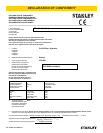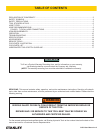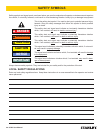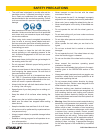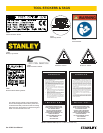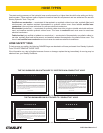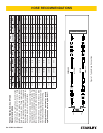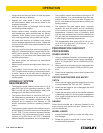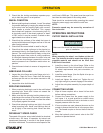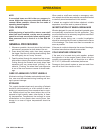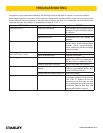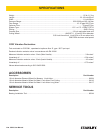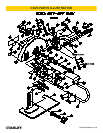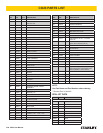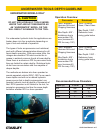
10 ► CO23 User Manual
• Always store an idle cutoff saw in a clean dry space
safe from damage or pilferage.
• Replace the cutoff wheel if worn for maximum
tool performance. Make sure that the wheel is not
chipped or damaged.
• Always keep critical tool markings, such as labels
and warning stickers legible.
• Always replace hoses, couplings and other parts
with replacement parts recommended by Stanley
Hydraulic Tools. Supply hoses must have a mini-
mum working pressure rating of 2000 psi/140 bar.
• All hoses must have an oil resistant inner surface
and an abrasive resistant outer surface. Hoses that
conform to SAE100R1A are recommended for most
tool applications.
• Use only cutoff wheels that meet requirements of
ANSI 87.5. Wheels should be no larger than 10-inch-
es/25.4 em in diameter, 5/32-inch/4 mm thick with a
1-inch/25.4 or 22 mm arbor hole. Rated speed must
be 5000 rpm minimum.
• Tool repair should be performed by experienced
personnel only.
• Make sure all couplers are wiped clean before con-
nection.
• The hydraulic circuit control valve must be in the
“OFF” position when coupling or uncoupling hydrau-
lic tools. Failure to do so may result in damage to
the quick couplers and cause overheating of the hy-
draulic system.
HYDRAULIC SYSTEM
REQUIREMENTS
• The hydraulic system should provide a ow of 10-15
gpm/38-57 lpm at an operating pressure of 1500-
2000 psi/105-140 bar. Recommended relief valve
settings are 2100-2250 psi/145-155 bar.
• The system should have no more than 250 psi/17
bar backpressure measured at the tool end of the
operating hoses. The system conditions for mea-
surement are at maximum uid viscosity or 400
ssu/82 centistokes (minimum operating tempera-
tures).
• The hydraulic system should have sufcient heat re-
jection capacity to limit the maximum oil temperature
to 140 °F/60 °C at the maximum expected ambient
temperature. The recommended minimum cooling
capacity is 7 hp/5.22 kW at a 40 °F/22 °C difference
between ambient temperature and oil temperature.
• The hydraulic system should have a minimum of 25
micron ltration. It is recommended that lter ele-
ments be sized for a ow of at least 30 gpm/1131
pm for cold temperature startup and maximum dirt
holding capacity.
• The hydraulic uid used should have a viscosity
between 100 and 400 ssu/20 and 82 centistokes
at the maximum and minimum expected operating
temperatures. Hydraulic uids of petroleum base
with anti wear properties and viscosity indexes over
140 will meet the recommended requirements over
a wide range of operating temperatures.
• The recommended hose size is .625 in/ 16 mm 1.0.
up to 50 ft/15 m long and .750 in/20 mm 1.0. mini-
mum up to 100 ft/30 m long.
PREOPERATION CHECKOUT
PROCEDURES
POWER SOURCE
1. Using a calibrated owmeter and pressure gauge,
check that the hydraulic power source develops a
ow of 10-15 gpm/38-57 lpm at 1500-2000 psi/105-
140 bar.
2. Make certain that the power source is equipped with
a relief valve set to open at 2250 psi/155 bar maxi-
mum.
3. Check that all operating controls and indicators are
easily accessible.
CUTOFF SAW TRIGGER AND SAFETY
CATCH
1. Check that the trigger operates smoothly and is free
to travel between the “ON” and “OFF” positions.
2. Check that the trigger is set to disengage the cutoff
saw when released.
3. Check that the safety catch on the handle assembly
is operating properly. It should prevent engagement
of the trigger unless the catch is fully pressed down
into the handle slot.
HANDLE
Check that the handle bar is securely fastened to the
motor housing and handle bar strut. Remove any oil
from the handle bar.
WHEEL GUARD
1. Inspect the wheel guard for cracks and other struc-
tural damage.
2. Rotate the guard to ensure that it moves freely on
the wheel-arbor centerline.
OPERATION



